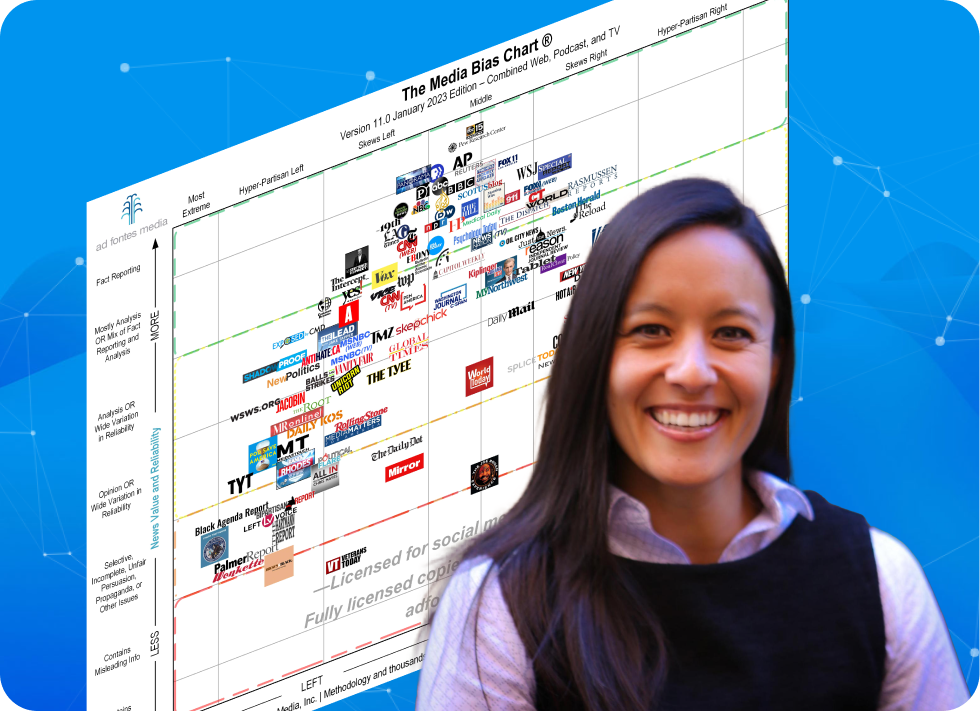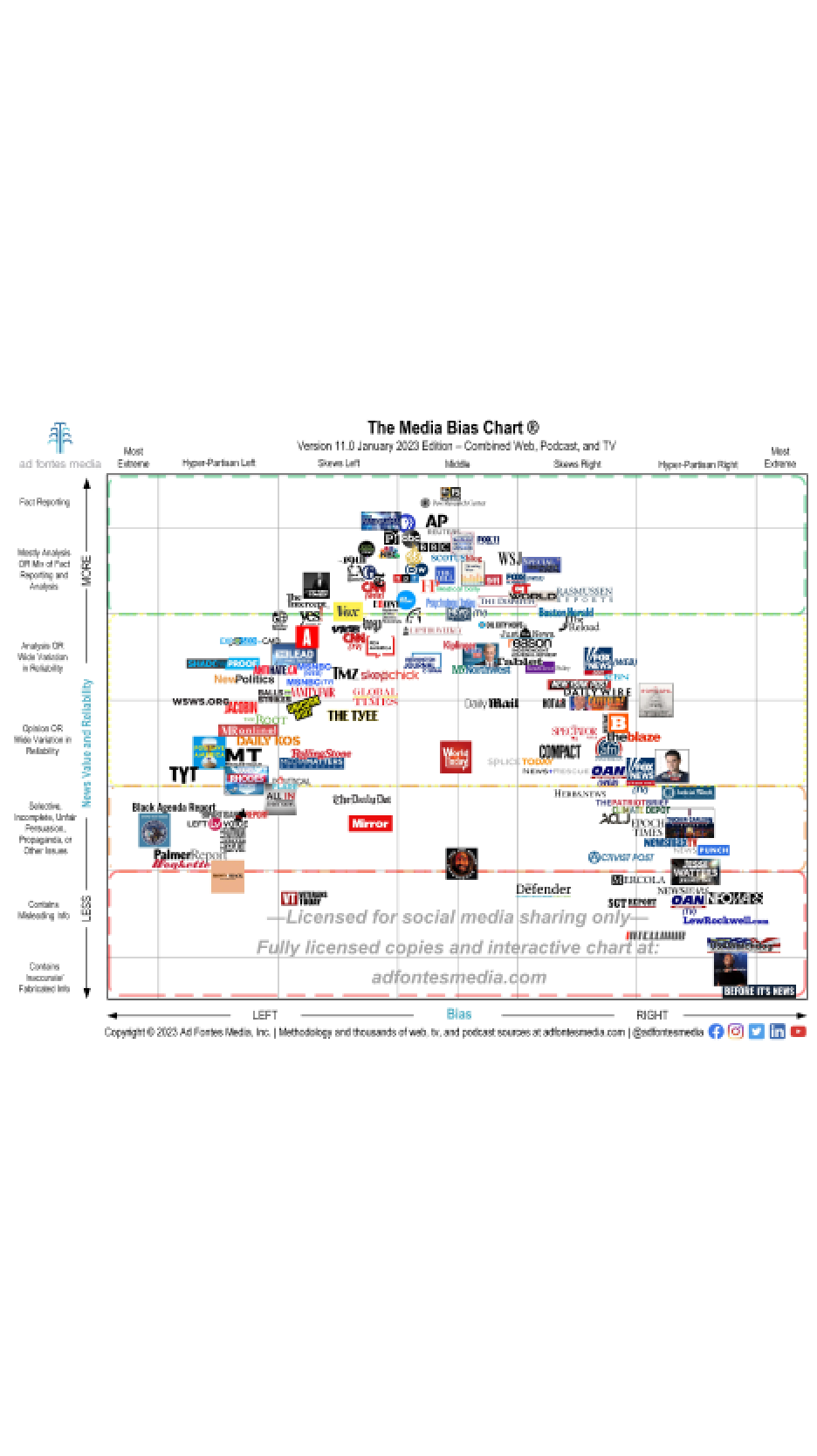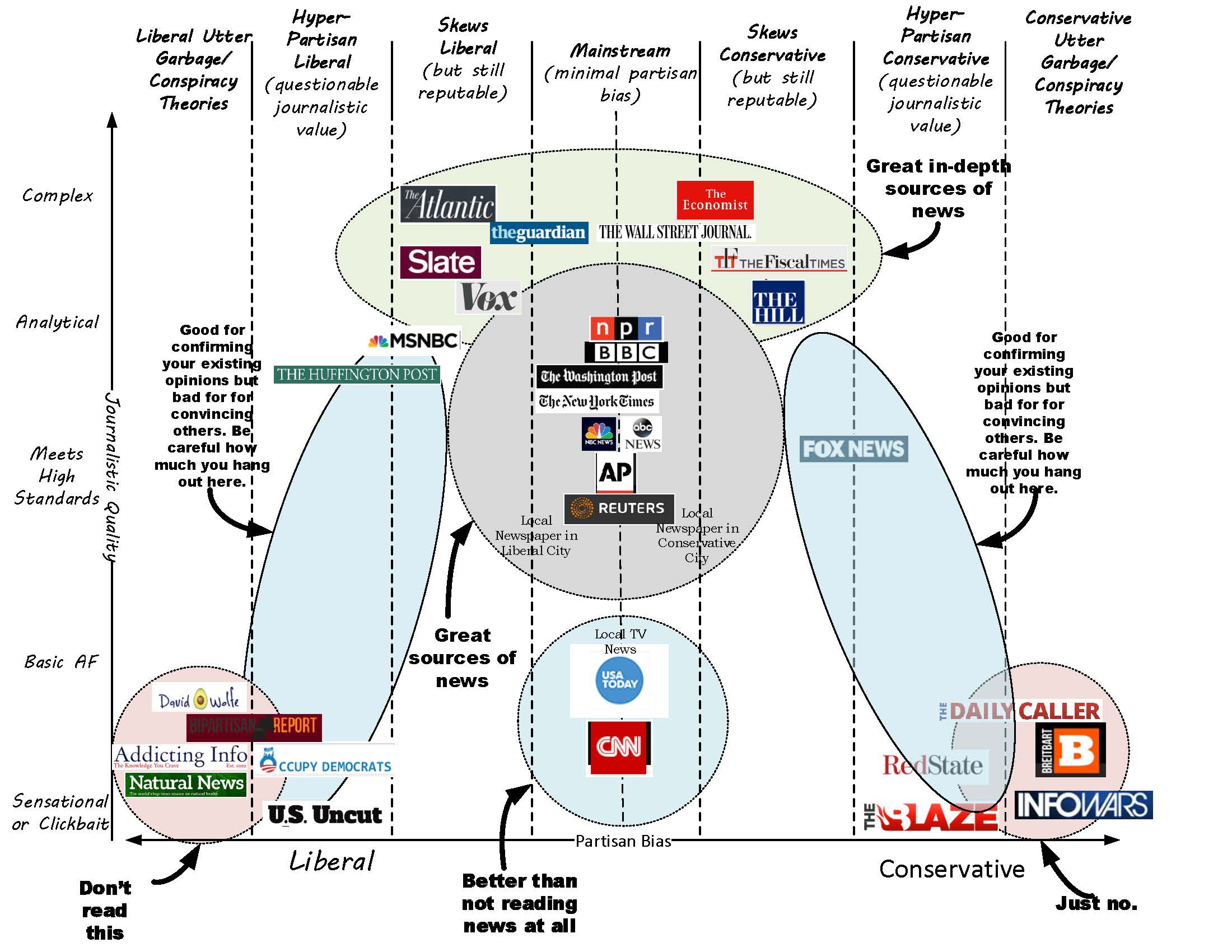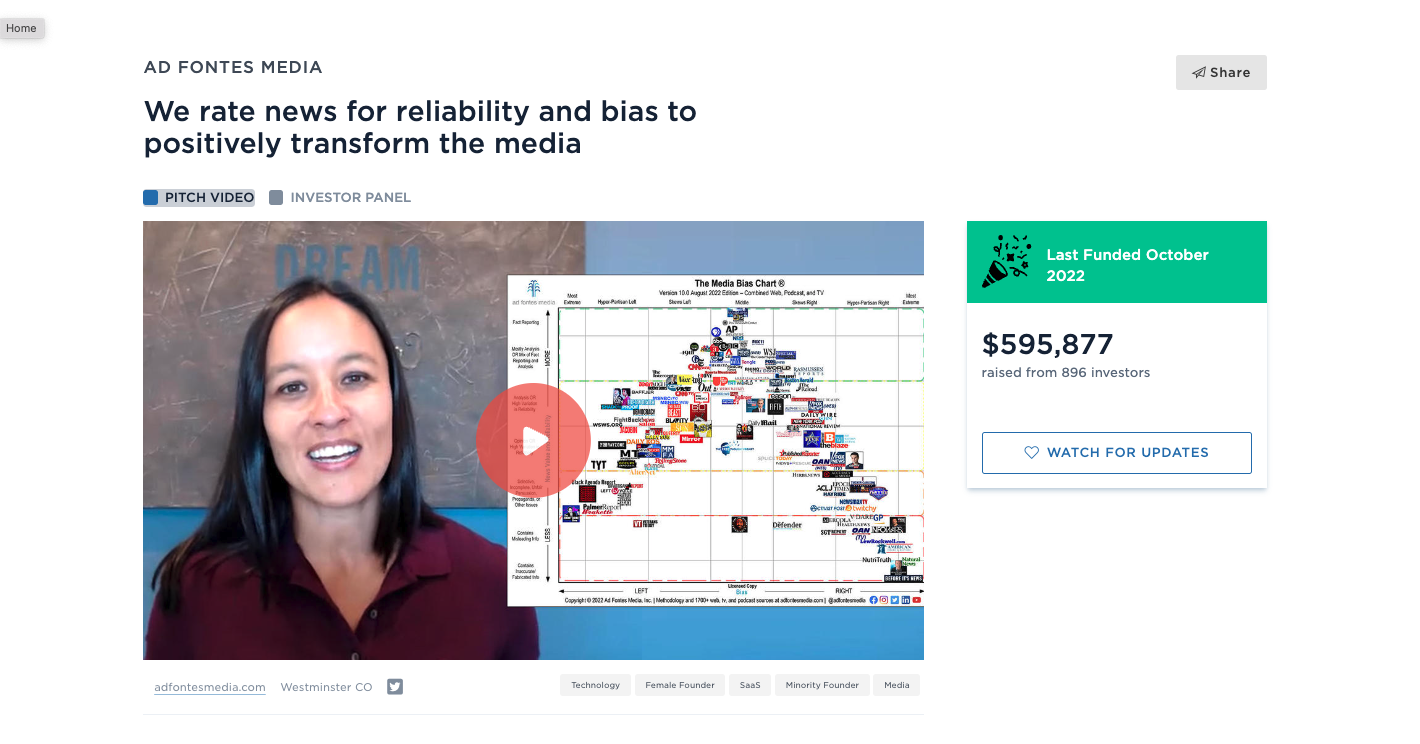
Making News Readers Smarter
How Ad Fontes Media raised $600K from 900 community members to rate the news for reliability and bias


- There has never been more news online than today. From thousands of articles to Tiktoks to Youtubes to podcasts every month, how do we build the chops to navigate it all?
- Vanessa Otero tackled this question in 2016 by mapping news sources like CNN and The Washington Post across two axes: bias and reliability. Her simple infographic went viral and spawned Ad Fontes Media.
- A visionary in a new media landscape, Vanessa had trouble raising money from VCs and angels. But she had a message that resonated with over 300K monthly website visitors, who engaged regularly.
- After two successful Community Rounds, she closed $1.2M in follow-on funding from VCs and angels who saw her product validated with their own eyes.
- How did it all go down?
MAKING NEWS READERS SMARTER
We’ll have Ad Fontes Media Founder & CEO, Vanessa Otero, take it from here →

What is Ad Fontes Media?
Ad Fontes Media helps people navigate the news landscape by rating news for reliability and bias.
Our community runs the gamut of advertisers, brand safety folks, librarians, and educators teaching media literacy. We’ve rated thousands of news and information sources across websites, TV, and podcasts. Our goal is to rate all the news and transform the media landscape for the better.
I founded Ad Fontes Media unknowingly in 2016, during the Hillary vs Trump election. People would fight viciously every day on my Facebook feed, hurling news links at each other, unfriending each other, and convincing no one of anything new in the end.
I was like, “You know what? Some news sources are better than others. Some are left and right, and some are really extremely so. How come people can't tell the difference? Let me make a visual map of the media landscape.”
So I did that, because I'm a giant nerd. When I wasn’t being a lawyer full-time, I spent my free time mapping the news landscape in an infographic that I called the Media Bias Chart.
Then I put it online and it went massively viral, which caught me by surprise.
For a couple years, I kept responding to a constant stream of comments on this side-project-blog of mine while being a full-time patent lawyer. Wefunder is what allowed me to take the leap into building Ad Fontes Media full-time.

Wefunder is what allowed me to take the leap into building Ad Fontes Media full-time.
Vanessa OteroFounder & CEO of Ad Fontes Media
Why we raised our 1st Community Round
After the first Media Bias chart went viral, people kept asking for the same things over and over: the data behind the chart, the methodology of the ratings, more news sources, and “can you make the chart interactive?”
I was like, “I’m a lawyer, I don’t have time to do this. I would have to hire people and it would be a whole thing. Would people actually donate money to make this happen?”
So in 2018, I put up my first crowdfunding campaign on Indiegogo and raised $32,000. That was enough to hire some part-time analysts and part-time developers to keep evolving the original chart.
By 2019, we started getting commercial traction. Big publishers asked, “Hey, could you do a big audit of 500 of our articles, and we’ll pay you a bunch of money for that?" A social media company asked us for the same thing.
At that point, I decided to try raising venture capital. I thought, “I’m a lawyer, I have a good idea, I work with startups, I have a decent network. I’ll pitch, and people will give me money for this.” As we all know, that's easier said than done—especially when you're super early and don't have all the pieces figured out yet. VCs didn’t get it, and I got rejected from pitch competitions and accelerators that I didn’t even feel were that competitive.
But even though VCs didn’t get it, everyday people did. We had a lot of website visitors—around 300,000 a month. Our email list had 30,000 subscribers, and I didn’t even know 75% of my Indiegogo backers. That’s uncommon in crowdfunding—normally you have to bring your own people.
All of that showed me that our message was resonating. On the 1000th version of my deck and still getting no’s everywhere, I thought I would take another look at crowdfunding.
A couple things drove me particularly to Wefunder. There are other crowdfunding platforms out there, but they seemed really selective. I would have to fill out a profile, which is a ton of work, and I still might not be selected to raise. But with Wefunder, if you can show that you've got investors bringing some money to the table (the minimum was $10,000 at the time), then we could launch it publicly.
We launched our first Community Round at the end of 2020, again during a presidential election. The times were unfortunate for our democracy but fortunate for our Community Round: misinformation was rampant, and people were desperate for a solution like Ad Fontes Media. From September 2020, we closed $350,000 from over 500 community investors in 5 months.
Even though VCs didn’t get it, everyday people did.
Vanessa OteroFounder & CEO of Ad Fontes Media
Why did people invest?
Why we raised our 2nd Community Round
After our first raise on Wefunder, which was a SAFE at a $5 million valuation cap, we offered a similar SAFE ($5 million valuation cap and 15% discount) to angel investors under Reg D. After putting together our Community Round investors and our Angels, two small venture funds, one called Horizon Fund and a prolific LGBT angel syndicate called Gaingels, joined the round. In total, we raised $800,000 and called it our pre-seed round.
A few months later, in the beginning of 2022, we raised a $500,000 seed round led by a lead investor who also saw our Wefunder round as a positive signal—a sign that I was scrappy and capable of raising from both the community and traditional angels.
Mid-2022, we decided we weren’t quite where we wanted to be on our seed round. 2022 hasn’t been the easiest year for founders to raise money. I don’t wanna make people sick of the words “the macro-environment,” but that was definitely an excuse for a lot of VCs to pull back.
We decided to open a bridge funding round back up to our community on the same terms of our seed round. This time it was a priced round at an $8.25 million valuation, so the shares ended up being Series Seed preferred shares at about $0.73 per share. We raised Reg D funds under the same terms as our Reg CF. It works really nicely that you can raise on and off Wefunder and offer the same terms to your community as you offer to professional investors.
Over three weeks, we closed on about $250K of funding. This round gives us enough to get to the next step: hiring Spanish language analysts and investing in AI development for our software tools.
I really appreciate Wefunder because of what it does for underrepresented founders and what it did for me.
Vanessa OteroFounder & CEO of Ad Fontes Media
The impact of our Community Rounds
Lowering the barriers: A lot's been said about the difficulties of female founders and founders of color raising venture capital. Those barriers are real, and Wefunder’s stats and numbers show that they’re lowering the barriers for female founders and founders of color. I really appreciate Wefunder because of what it does for underrepresented founders and what it did for me.
Follow-on funding: I bristled when I would hear traditional VCs say this old school thing like “your crowdfunding is a negative signal.” I'd be like, “Please, my gender is a negative signal and you don't even realize.”
Raising a Community Round is a positive signal: people believe in us. Lots of people believe in us. And it's not like people just walk around throwing you money. You have to have a community, you have to have something that people believe in, and you need to coalesce them around a particular action that you want them to take.
Getting your house in order: For founders who are thinking about doing a Community Round, there are legal and regulatory things to consider, but it's good for getting your house in order. You gotta do your financials, you gotta get them reviewed, you gotta make sure you have lots of due diligence documents ready to go. I think it's a good crucible for early stage companies.
It’s not like people just walk around throwing you money. You have to have a community, you have to have something that people believe in, and you need to coalesce them around a particular action that you want them to take.
Vanessa OteroFounder & CEO of Ad Fontes Media
Summary
Ad Fontes Media raised $595,877 from 896 investors during their Wefunder Community Round.

Snapshot of Ad Fontes Media's Community Round (source wefunder.com/ad-fontes-media)
The Raise
- 1st Community Round raised $350,000 in 5 months
- 2nd Community Round Raised $250,000 in 3 weeks
- Raised $600,000 total from 896 investors and $1.2M in follow-on funding
Investor Stats
- 40% of investors invested $100
- 80% invested $500 or less
- 10% of investors invested more than once












































